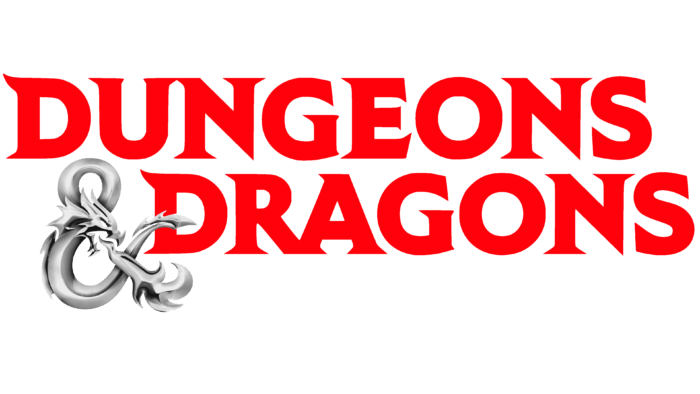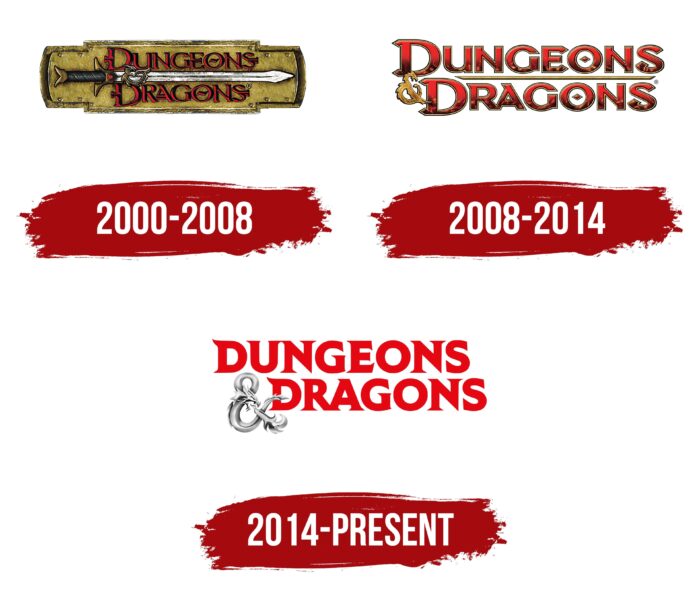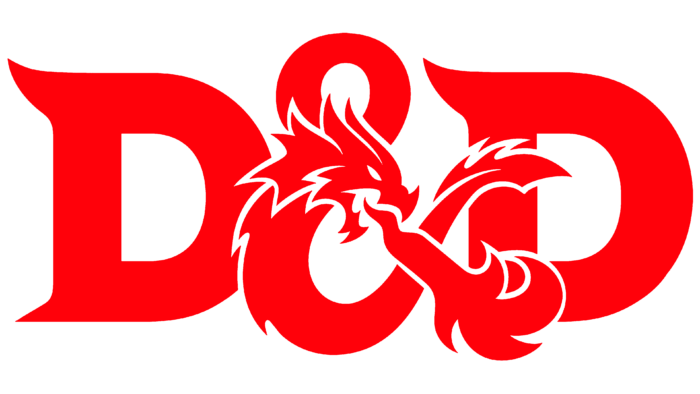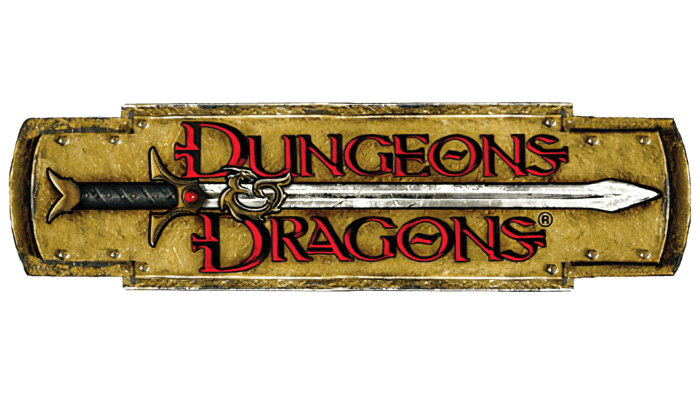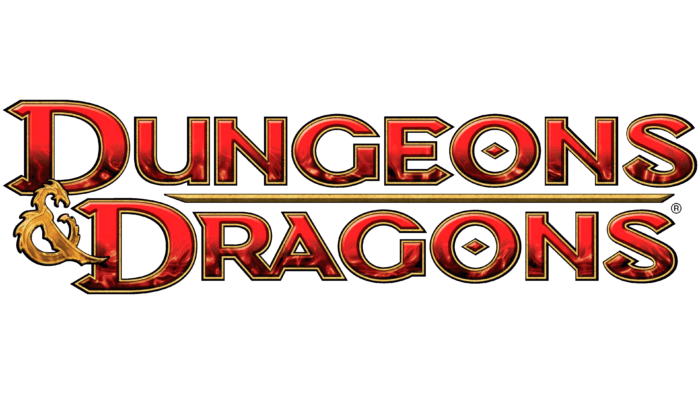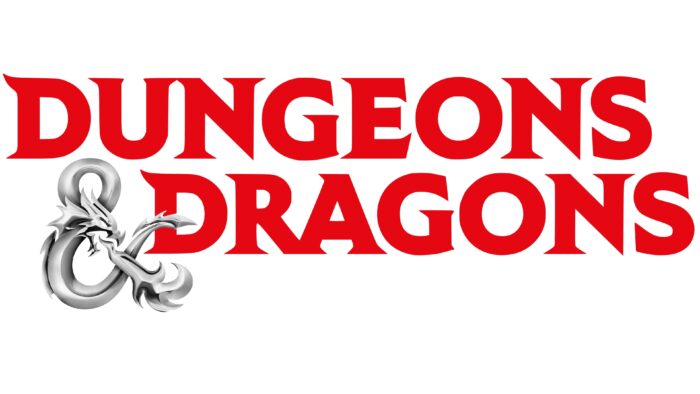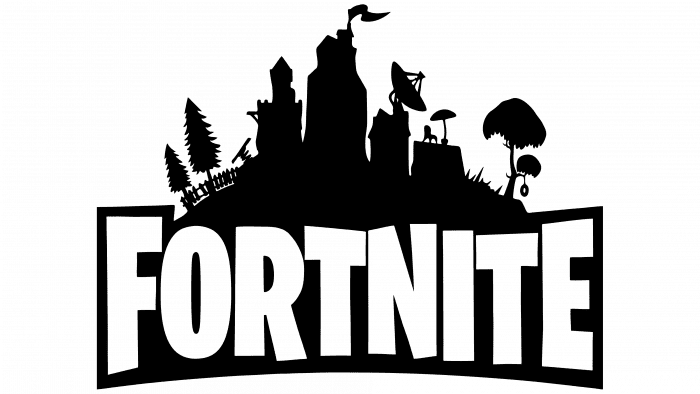The emblem shows the game, like a dragon’s flame, is exciting and addictive. The emblem of Dungeons & Dragons conveys bright emotions, the energy of the struggle, and the desire to win. After spending time with dragons, players want to stay in this magical fairy tale world.
DnD (Dungeons & Dragons): Brand overview
DnD (Dungeons & Dragons) is a board game in the fantasy role-playing game genre. It has been around for a long time, gaining popularity at the time of its release – in 1971. It was invented and developed by Gary Gygax and Dave Arneson and released by Tactical Studies Rules Corporation. Legend is published by Wizards of the Coast (a subsidiary of Hasbro). It has been published since 1997. D&D is now a separate universe with its own philosophy, rules, and occupation. The fifth edition includes three rulebooks: Player’s Book with game conditions, Monster Encyclopedia with information about monsters, and Master’s Guide with hints. Each of the released variants is sure to have dice to roll and figures to play with. Commercial success has led to other media products of the same name: a magazine, an animated series, a movie, books, video games, and many game aids.
Meaning and History
The prototype of Dungeons & Dragons was wargames – miniature models of battlefields with detail. The original rules system was borrowed from the Chainmail variant of the game, released in 1971. Therefore, DnD is now recognized as the forerunner of modern role-playing games and the RPG industry as a whole.
In the course of the action, instead of a military formation, participants can choose their hero. Characters embark on a fantasy adventure, with the Dungeon Master acting as the judge. Heroes form groups and interact with each other and with the population. Together, they solve problems, accumulate knowledge, collect treasures, explore the terrain, and participate in battles. Players earn special points by competing to see who earns the most. The points earned allow you to advance to the next level and become stronger.
The instant success was a powerful boost to the rapid spread of D&D. It is still the leader among role-playing games, having split into two parts in 1977: fantasy with easy conditions and combat with a heavy rules system. In 2017, Dungeons & Dragons recorded the largest number of participants addicted to the game, with between 12 and 15 million people in North America alone. At the moment, there are five editions, the last of which appeared in 2014. And the game has only two emblems.
The individual sign of the board game has spread to all kinds of products, as its popularity has led to the appearance of animated series, comic book magazines, books of the same name, a large number of role-playing video games, and other varieties of the DnD game.
2000 – 2008
The original version of the DnD (Dungeons & Dragons) logo was stylized to fit the game’s plot. For this purpose, the designers chose a harmonious combination of military weapons (swords) with the name. They divided the phrase into fragments and arranged them in two lines. The letters resembled ancient symbols: blood-red, shaped, graceful, with long strokes and black shadows. Due to a special combination of light and dark sides, the signs in the text were sharply angular. And the short stripes drawn on them were perceived as flames.
Between the first and second rows, there was a sharp sword. The blade of the cold weapon was wide and shiny, with a deep groove stretching from the hilt to the tip. The blade was covered with a noble patina. The hilt had a complex structure, but the figural elements were arranged symmetrically. According to the designers’ idea, it was a dark gold decoration adorning the hilt made of black leather. The background was a gold plate in a frame with twelve screws. An ampersand in the form of a curved dragon was placed between the words “Dungeons” and “Dragons.” To the left of the mythical character was a red ruby.
2008 – 2014
The debut logo contained a lot of decorative elements and had a gothic design. The style of the inscription, its design, and the amazing golden ampersand resembling the silhouette of a fairy-tale dragon contributed to this. The letters were capitalized, accented with the first “D,” so that visually they formed the abbreviation D&D. The ends of the letters “E,” “D,” “R,” and “A” had pointed serifs that resembled spades. The letter “S” had a serif only at the bottom. The letter “O” had a vertical rhombus in the middle. The letters were painted in disturbing colors – raging flames with yellow tongues of fire at the bottom. This brutal and massive logo brilliantly conveyed the energy of the game, its concept, and its story. In between the words was a narrow band resembling a sharp blade.
2014 – today
The emblem is still divided into two halves, one graphic and the other textual. The word combination occupies two lines. The letters are made in red color and decorated with serifs. They are present in all symbols and look like needle-shaped protrusions. At the same time, the appearance of letters has changed – they have become larger clearer, with a large interval. The exception is the combination of “RA,” which is written fused because the legs of “R” and “A” are connected. Between the top and bottom of the name is the original ampersand: a silver-gray, cold, steel sign in the form of a vignette. This is the dragon, a fantasy character from the game’s story.
DnD (Dungeons & Dragons): Interesting Facts
“Dungeons & Dragons” (D&D) is a fantasy tabletop role-playing game created by Gary Gygax and Dave Arneson. Launched in 1974, it’s considered the first modern role-playing game and sparked the creation of the RPG industry.
- Creating a New Genre: D&D was the first RPG for sale, blending war gaming with story-driven adventures and characters that grow over time.
- Video Game Inspiration: Many video games have borrowed from D&D. Ideas like health points, experience points, levels, and character classes started here.
- Controversy: In the 1980s, D&D was caught up in the “Satanic Panic,” falsely accused of promoting harmful themes. Despite this, its popularity grew.
- Many Versions: D&D has evolved through many editions, updating rules and expanding its universe, but it’s always kept its essential charm.
- Rich Worlds: The game is famous for its detailed settings, like the Forgotten Realms and Eberron, which have been explored in books and other media.
- Celebrity Fans: Stars like Vin Diesel and Stephen Colbert have shared their love for D&D, helping it gain wider acceptance.
- Live Streaming: Shows like Critical Role, streamed online, have brought D&D to a huge audience, even inspiring spin-offs and an Amazon Prime animated series.
- Benefits: D&D can boost creativity, problem-solving, and social skills. Some teachers even use it as an educational tool.
- Surging Popularity: The latest edition has led to record sales, thanks to its easy-to-learn format and online and geek culture growth.
- Beyond the Tabletop: D&D has inspired novels, movies, and a TV show. While not every adaptation has been a hit, they’ve all helped spread D&D’s influence.
“Dungeons & Dragons” has transformed from a niche hobby into a major part of pop culture, leaving its mark on gaming and beyond. It is legacy and continuous innovation mean it will keep inspiring players for years.
Font and Colors
The emblem uses a personalized DnDC font designed by Zentron. The alternative is Masquerade, designed by Martin Waite. Anyway, it is an uppercase font with thin but clear horizontal serifs. They perfectly balance the thick letters. In both versions, the strokes of the letter “D” are elegantly curved and point upwards.
The current logo uses a combination of red and silver colors. The cold chrome looks fresh and contrasts against the scarlet color, symbolizing passion, emotional peak, and blood spilled during battles. An earlier version used gold instead of silver.
DnD (Dungeons & Dragons) color codes
| Red | Hex color: | #ff010a |
|---|---|---|
| RGB: | 255 1 10 | |
| CMYK: | 0 100 96 0 | |
| Pantone: | PMS 1655 C |
| Dark Gray | Hex color: | #a9a9a9 |
|---|---|---|
| RGB: | 169 169 169 | |
| CMYK: | 0 0 0 34 | |
| Pantone: | PMS Cool Gray 6 C |
| Eerie Black | Hex color: | #141414 |
|---|---|---|
| RGB: | 20 20 20 | |
| CMYK: | 0 0 0 92 | |
| Pantone: | PMS Black 6 C |
